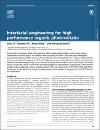Interfacial engineering for high performance organic photovoltaics
| المؤلف | Yi, Chao |
| المؤلف | Hu, Xiaowen |
| المؤلف | Gong, Xiong |
| المؤلف | Elzatahry, Ahmed |
| تاريخ الإتاحة | 2021-03-31T08:18:06Z |
| تاريخ النشر | 2016 |
| اسم المنشور | Materials Today |
| المصدر | Scopus |
| الرقم المعياري الدولي للكتاب | 13697021 |
| الملخص | In the past two decades, bulk heterojunction (BHJ) organic photovoltaics (OPVs) have gained tremendous attention due to its intrinsic merits of cheap, flexible, clean and high throughput manufacturing processibility and its advanced features of short payback time. Various methodologies have been developed to approach OPVs with high power conversion efficiencies (PCEs) and long-term stability. Interfacial engineering is a proven efficient approach to achieve OPVs with high PCEs. In this article, we provide a basic overview on the recent progress of the materials, in particular, water/alcohol soluble organic materials, used as interfacial layer (IFLs) in engineering of BHJ OPVs with high PCEs. Underlying device physics of interfacial engineering and the origins of enhanced PCEs of OPVs by IFLs are highlighted. |
| راعي المشروع | The authors would like to thank NSF and Air Force Research for financial support. |
| اللغة | en |
| الناشر | Elsevier B.V. |
| الموضوع | Condensed matter physics Materials science Bulk heterojunction (BHJ) High power conversion High throughput Interfacial layer Intrinsic merits Long term stability Organic materials Organic photovoltaics Heterojunctions |
| النوع | Article Review |
| الصفحات | 169-177 |
| رقم العدد | 3 |
| رقم المجلد | 19 |
تحقق من خيارات الوصول
الملفات في هذه التسجيلة
هذه التسجيلة تظهر في المجموعات التالية
-
علم وتكنولوجيا المواد [311 items ]



